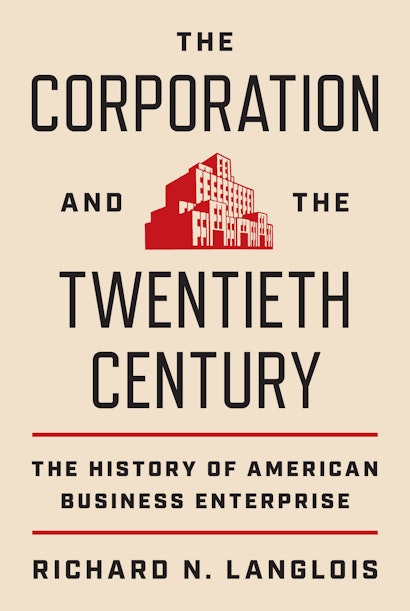The COVID-19 pandemic has made the world aware of supply chains, the upstream and downstream—economists would say “vertical”—relationships among the producers of the parts that go into complex systems products like cars and smartphones. We now recognize that external events like pandemics can throw supply chains into chaos, often inducing manufacturers to bring more links under their own control. We are also becoming aware that government policy can influence the degree of vertical integration by encouraging or discouraging outsourcing, especially across international borders. In fact, however, both external events and government policy have long affected the degree of vertical integration, and they have done so in ways that profoundly influenced the shape and extent of the American corporation.
The corporate form is ultimately a system of economic institutions, one alternative in many ways to similar institutions in the larger sphere of market activity. When external events hamper or destroy market exchange along the supply chain, internal organization offers a substitute—though perhaps a second-best substitute. It is this process of institutional substitution, far more than the inherent superiority of internal organization as a system of large-scale planning, that explains much of the rise to prominence of the large multi-unit American corporation in the middle of the twentieth century.
To be sure, external forces and government policy are by no means the only drivers of vertical integration and disintegration. When products and processes are changing radically, especially in a systemic way, firms tend to pull activities in-house so that they can better understand, adjust, and create the production process. Like all auto manufacturers in the early twentieth century, for example, Ford Motor Company began as an assembler of parts made by others. But as the company began developing the process of mass production in earnest, it famously integrated vertically into the manufacture of virtually all the parts of the Model-T, first at its Highland Park Plant and then at a giant complex on the River Rouge. With the production process in flux—and with much of it still to be invented—Ford found it costly to work with outside suppliers, both because of the difficulty of specifying what was needed and because Ford had itself developed capabilities superior to what existed among outside suppliers.
Yet, at the margins, external forces have long influenced integration decisions and helped shape the corporation.
Many attribute the relative success of Tesla Motors in today’s market for electric vehicles to the company’s high degree of integration, especially into software; the company even makes its own batteries. Tesla is inventing and fine-tuning the electric vehicle, much as Ford was inventing and fine-tuning the Model-T, and synoptic control can often facilitate that process. But it is also significant that during the pandemic Tesla’s vertical integration gave it advantage over firms, including many of the traditional automakers, that outsourced software and parts to a greater degree and thus suffered more supply-chain disruptions.
The COVID-19 pandemic was far from the greatest external event that American industry has experienced. The middle years of the twentieth century—years of devastating depression and total war—were far more destructive of markets and market-supporting institutions than was the recent pandemic. The Great Depression destroyed financial networks and eliminated many other nodes of market transaction. World War II elevated non-market modes of resources allocation over market modes. In this catastrophic environment, the corporation became a safe haven, with its own internal stores of cash and an ability to act as an internal capital market.
Government policy can and has also significantly affected the choice between internal and external institutions of transaction. It is a great irony, for example, that despite its general hostility to the large corporation, antitrust policy has often, and perhaps mostly, worked unintentionally to favor internal corporate modes of governance over more decentralized market modes of governance.
The Sherman Antitrust Act of 1890 made it illegal for small independent firms to collude. At the same time, the relatively unrestricted corporate charter emerged as a kind of modular institutional container in which transactions could take place unobserved. As the twentieth century dawned, small firms in many industries merged at astonishing speed to form large holding companies, which seemed to offer a legally safe alternative to cartels. But holding companies engendered widespread suspicion and even fear, especially because holding companies were permitted to own the stock of other companies, sometimes creating multilevel pyramids of control. The courts began ruling that whenever corporate entities were made up of holding companies that could conceivably have competed with one another, those entities were guilty of restraint of trade. On this basis enterprises like Standard Oil, American Tobacco, and Du Pont were broken up. American business learned that the modular form of the holding company had morphed from a safe haven to a source of danger. The solution was to create unified, centrally administered—effectively non-modular—organizations that would not be so easy to break up. The large multi-unit enterprise of the twentieth century was born.
But central planning of a complex production process works no better within an organization than it does within an economy. American firms needed to establish a new way to modularize themselves in emulation of the market. They did this by setting up largely independent product-oriented divisions, creating what came to be called the multidivisional or M-form structure. For example, during some periods General Motors’s car brands—Chevrolet, Buick, Pontiac, Oldsmobile, Cadillac—were each produced within their own separate divisions. In the face of the intense antitrust regime that emerged after the war, however, GM and other large companies began to fear that modularity would once again provide the antitrust authorities with clean break points for dismemberment. Like other firms, GM scrambled its M-form in response, creating the General Motors Assembly Division, which would preside over all the company’s increasingly dysfunctional manufacturing plants. The incentive to scramble corporate structure was reinforced by the strong industry-wide unionism that had emerged from the Depression, as firms deskilled their once-innovative suppliers and pulled activities in-house to better control labor relations. It is arguable that these corporate responses contributed materially to the failings of the industry at the end of the century in the face of Japanese competition.
The crucial lesson is that business is transacted not merely in “the firm” and “the market” but by means of a skein of complex institutions that are often imperfect substitutes for one another. Contrary to its portrayal in formal theory, “the market” itself is not merely about price-mediated spot transactions between anonymous buyers and sellers but is most often a system of complex and often puzzling contractual arrangements. Economists have come to see many if not most of these contractual arrangements as designed to solve vexing problems of uncertainty, incentives, and transaction costs. In the popular mind, and all-too-often in the halls of the antitrust authorities, the same arrangements are often dismissed as “unfair” or “anticompetitive” practices. What is often forgotten is that many times forbidding such practices will induce firms to relocate the targeted transactions behind the corporate veil, thus evacuating the institutional space between the corporation and the anonymous market. Since the beginning of the twentieth century, policies aimed at fostering decentralized competition have frequently had the unintended consequence of bolstering the large multi-unit enterprise.
Richard N. Langlois is professor of economics at the University of Connecticut. He is the author of Firms, Markets, and Economic Change: A Dynamic Theory of Business Institutions (with Paul L. Robertson); The Dynamics of Industrial Capitalism: Schumpeter, Chandler, and the New Economy, which won the Schumpeter Prize of the International Joseph A. Schumpeter Society; and other books.

